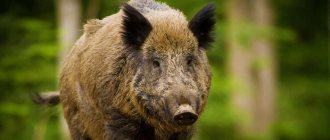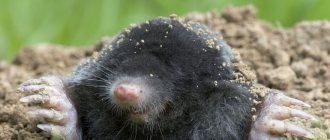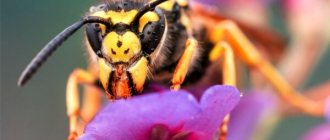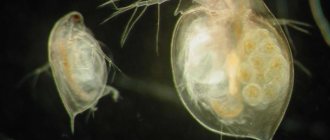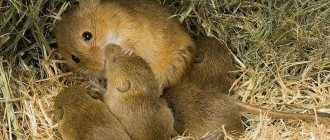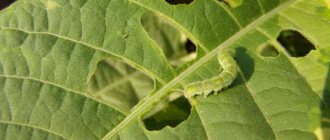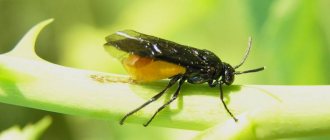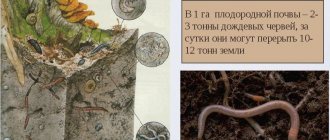A little anatomy
The body can be from 1.5 to 15 cm in length. It can be conditionally divided into three parts: head, chest, abdomen. There are two pairs of wings. On the massive head there are organs of touch (whiskers) that are longer than the body. The eyes are big.
Males are smaller than females. 3 pairs of legs. The chirping sound is made by the elytra, one of which is a “bow”, the second is a “resonator”. Each variety has its own sound scale. The ears are located on the front legs.
If you carefully look at the photos of grasshoppers, you can see a lot of interesting and unusual things.
Loud-voiced singer
The grasshopper chirps on a cool day or in the evening, and occasionally at night. This happens thanks to its elytra, which act as a kind of musical instrument.
As a result of vibration, a sound appears that intensifies when the insect's wings rise. Each type of grasshopper has its own melody.
It is called the music of nature. During the mating season, males make a peculiar crackling sound, which females cannot do.
Sensing danger, the grasshopper immediately falls silent. This is how he escapes from his enemies. To hear a clear-voiced singer, you should not talk loudly or make sharp sounds. Listen to the silence and you will hear the trill of a grasshopper.
Chirping, what is this?
Above we briefly explained how a grasshopper chirps. Now let's look at the process in a little more detail.
The left elytra is equipped with a membrane with a special serrated vein, which is called stridulatory. It is she who plays the role of a “musical reed”.
On the right there is a resonator membrane. To produce a chirping sound, you need to vibrate the elytra.
The melodies and volume are different, depending on the type of insect. The sounds are most often made by the male. However, there are several species where the female shows her musical abilities.
Favorite food
A grasshopper will gladly swallow a caterpillar, a butterfly, small insects, larvae, and even representatives of its own species that turn out to be weaker than it. But he does not disdain plant foods, namely: grass, stems, flowers, cereals and the like.
Oddly enough, grasshoppers even bite people (though not to get enough) who threaten them. The bite of a grasshopper is painful, because the insect has strong, powerful jaws.
Appearance
Externally they also differ. Grasshoppers are most often green. This color helps them camouflage themselves in foliage to make it easier for them to forage for food.
They have a movable head with sharp jaws. Powerful hind legs, short front legs. Incredibly long whiskers, which locusts do not have.
The body of the locust is brown or yellow, although it can be green, brown, or gray. The antennae are short, as long as the head. The hind legs are shorter but stronger. We hope it is now clear how to distinguish a grasshopper.
Color palette
The color of a grasshopper depends on its habitat and species. The grasshopper living in Russian meadows and clearings or in the tropical zone has a camouflage green color. A desert grasshopper or one that has chosen a marshy area is spotted and brown.
South African grasshoppers camouflage themselves with the color of rocks to escape predators. Striped and peacock colors are also found. But orange and red grasshoppers came to Russia from China, and you can only admire them in greenhouses.
Reproduction and lifespan
Insects living in the temperate climate zone begin to “make friends” in late spring and early summer. During this period, you can hear the roulades of the males.
Their seminal fluid is stored in a capsule covered with a nutrient mixture.
During mating, they attach the capsule to the female's abdomen. She begins to feast on the bait mixture, and at this time fertilization occurs.
Then a clutch is made, which can contain from 100 to 1000 eggs. It can be found everywhere: on branches, stems, bark, etc.
After a while, larvae appear, similar to grasshoppers, only miniature. They grow and shed. Shedding can be 4-8 times.
At this stage, wings appear. After the last molt, the grasshopper waits for the wings to be fully restored and sets off on the journey called life.
Do you want to know how long a grasshopper lives? Taking into account all stages of development, its life expectancy is just over a year. If you keep a record from the moment of “adult” life, then it turns out to be only one summer. As soon as cold weather sets in, the insect dies.
Habitats
The grasshopper can be found in every corner of the earth except Antarctica. He prefers green edges, valleys, gorges in which lush grass grows. In Central Asia, it lives high in the mountains, trying to hide among plants from the scorching sun.
In the Alps, the grasshopper chooses high-mountain meadows, loves open spaces, and avoids forests. You can meet a grasshopper in the Far East and Africa, in Denmark and Finland, in England and in the sultry jungle.
Photos of grasshoppers
If you fight, then how?
Plants should be located away from grasshopper egg laying sites. If the green warbler nevertheless settles on the site, pesticides, means for killing beetles, and various kinds of bait with poison are used.
But there are also mechanical methods of protection: digging up the soil in the fall, and loosening the rows more often in the summer.
Today, there are already biologically pure biological products that help fight insects. They are absolutely harmless to humans and animals.
Let's not forget about the birds, for whom the grasshopper is a real delicacy. If the area has been chosen by titmice, then the jumping singers will not stay there for long.
External structure of an insect
The green grasshopper is a large insect with a bright green color and long transparent wings. It is found throughout the Russian Federation, except for the very cold northern regions. Lives mainly in grass and bushes.
Head department:
- The mouthparts are located around the insect's mouth and covered by the lips. They serve to prepare captured food before swallowing.
- The upper jaw consists of mandibles; it grasps and then crushes food.
- The lower one has palps - organs of taste and touch.
- The antennae or antennae located on the top of the head are also used for the sense of smell and touch.
- The eyes have a complex facet structure. The grasshopper's visual acuity is not very high, so it can barely distinguish shapes.
- The organs of smell, touch and taste are represented by special hairs and pits; they are located not only on the head, but also on the body of the insect.
The head contains the central hub of the nervous system, designed to process signals and control all senses. The presence of sensory hairs throughout the body is of great importance for the survival of the insect.
Thanks to them, the grasshopper is able to distinguish vibrations with an amplitude half the size of an atom and detect odors at a very long distance.
Torso:
- The first part consists of a pronotum with a lateral lobe to protect the articulation of the head with the body. There is another nerve node in the insect’s chest that controls motor functions.
- The front leg consists of a coxa, a swivel and a femur; it ends in a tibia with an auditory apparatus and a tarsus with two claws.
- The hind leg has a similar structure, but due to the jumping ability of the insect, the limb has a thickened femoral part and an elongated tibia. The foot, in addition to the claws, has a sucker.
- The abdomen consists of segments, and on the sides there are special openings for supplying the body with air - spiracles.
- The forewings are very dense and rather narrow. They have an elongated shape and parallel arrangement of veins.
- The hind ones are wider with a longitudinal arrangement of veins.
Body color helps the insect blend in with its environment and remain invisible to predators. When jumping, a grasshopper can cover a distance of about a meter, and if it uses its wings, then up to 10 m.
Nutrition
Among the small insects that inhabit the Earth, there are also cruel predators. Grasshoppers are one of them. These are natural, skilled hunters. They try to grab their prey with lightning speed, using their forelimbs. They feed on larvae as well as small insects, eating small locusts, mites and aphids.
Grasshoppers also eat beetles, butterflies, and caterpillars. In cases of shortage of other types of food, especially if they find themselves captive in a confined space, they are capable of attacking their own relatives in a wave.
And sensing luck, the stronger will feast on the weaker with appetite, without hesitating at all. To get their required dose of nutrients, salts and protein, these insects are able to consume carrion and feces.
Grasshoppers can be attracted to plant leaves from plant food, but only on young shoots. There are species for which this type of nutrition is the main and even the only one.
However, in this case, the insatiability of grasshoppers sometimes harms cultivated and forest plants. But by eating harmful insects, in particular the Colorado potato beetle, which destroys potato plantings in huge quantities, grasshoppers turn out to be very useful.
Food[edit | edit code]
Contrary to popular belief, the vast majority of grasshoppers are omnivores with a penchant for carnivory. In fact, in many ways, grasshoppers are similar to praying mantises: they are also camouflage hunters, and also grab prey with their jagged front legs. But some species feed only on plants. Several species are reported as agricultural pests. Usually, due to the low population density compared to locusts and grasshoppers, the harm from them is insignificant, but some species in certain years are able to form different phases, like locusts, and then the damage from them becomes more noticeable.
Taxonomy[edit | edit code]
The following subfamilies are distinguished in the grasshopper family:
- Acridoxeninae
- Agraeciinae
- Austrosaginae
- Bradyporinae - Ball-headed grasshoppers
- Conocephalinae
- Copiphorinae
- Decticinae
- Hetrodinae
- Lipotactinae
- Listroscelidinae
- Meconematinae - Knotwhiskers
- Mecopodinae
- Microtettigoniinae
- Phaneropterinae - Plate wings
- Phasmodinae
- Phyllophorinae
- Pseudophyllinae
- Saginae - Dybki
- Tettigoniinae - True grasshoppers
- Tympanophorinae
- Zaprochilinae
